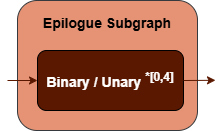Reduction Fusion Patterns#
Overview#
The Reduction category includes operations such as: ReduceL1, ReduceL2, ReduceMax, ReduceMean, ReduceMin, ReduceProd, ReduceSum.
oneDNN supports various reduction fusion patterns to optimize performance and reduce memory bandwidth requirements. This document describes the supported fusion patterns for Reduction.
Pattern Structure#
oneDNN defines floating-point Reduction fusion patterns as follows. The blue nodes are required when defining a Reduction fusion pattern while the brown nodes are optional.

Reduction Operation : Performs the corresponding reduction operation for the
srctensor. See the ReduceL1, ReduceL2, ReduceMax, ReduceMean, ReduceMin, ReduceProd and ReduceSum operations in the Graph API for more details.Epilogue Subgraph : Optional and can include the following operations:
Binary and Unary operations: refer to the Note in Fusion Patterns.
Combination Rules:

N=20, 0 to 20 Binary or Unary operations are supported in the epilogue subgraph.
Data Types#
oneDNN supports the following combinations of data types for src and dst:
src |
dst |
|---|---|
f32,bf16,f16 |
f32,bf16,f16 |
The definition of the data types and support status on different CPU and GPU platforms follow the general description in the Data Types Guide.
